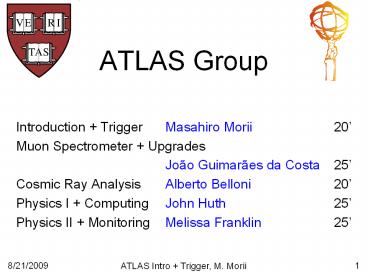ATLAS Group PowerPoint PPT Presentation
1 / 13
Title: ATLAS Group
1
ATLAS Group
- Introduction Trigger Masahiro Morii 20
- Muon Spectrometer Upgrades
- João Guimarães da Costa 25
- Cosmic Ray Analysis Alberto Belloni 20
- Physics I Computing John Huth 25
- Physics II Monitoring Melissa Franklin 25
2
Harvard ATLAS Group
- PIs Melissa Franklin, João Guimarães da Costa,
John Huth, Masahiro Morii - Postdocs Kevin Black, Alberto Belloni, Corrinne
Mills, Shulamit Moed new hire - Graduate Students Lashkar Kashif (G7 in
0910), Verena Martinez Outschoorn (G5), Srivas
Prasad (G5), Ben Smith (G5), Michael Kagan (G4),
Laura Jeanty (G3), Giovanni Zevi della Porta
(G3), Kevin Mercurio (G2) William Spearman (G1) - Undergrads Jack Kearney, Maria Baryakhtar,
Jeewoo Park, Michael Fountaine, Curt Nehrkorn,
Tomo Lazovich
3
Physics
- First LHC run, ECM 7 TeV
- Crucial for understanding the machine, detector
- Opportunities for early physics
- W, Z ? Z jets, WZ production
- Top quark production
- Future runs, ECM 14 TeV
- Link from early physics to discovery
- Z Higgs, same-sign dilepton, multi-lepton
- BSM tt-bar resonance
4
Muon Spectrometer
- Our primary responsibility and strength
- Production of endcap MDT chambers and MDT
front-end electronics - Vertical integration of MDT-related tasks
- Installation, commissioning, and operation
- DAQ software
- Online/offline data-quality monitoring
- Muon reconstruction software
- Validate and debug using cosmic ray data
- Target publication of µ/µ- ratio
5
ATLAS Trigger Developments
- Melissa Franklin, Corrinne Mills, Kevin Mercurio,
Ben Smith, Masahiro Morii
6
Introduction
Trigger-Aware Analysis
Reduction Techniques
Efficiency Measurement
Database Access
Physics Dataset
Derived Dataset
Trigger Efficiency
Final Analysis
Navigation Slimming
Trigger Offline Matching
Efficiency Framework
- Goal Give physics analysis access to detailed
trigger information - Harvard is a major contributor to the Trigger
Core Software and Trigger Analysis Tools groups
in ATLAS
7
Navigation Slimming
- Trigger Navigation structure offers full
information of the trigger decision process - Which algorithms were run, what their results
were, and what algorithms they seeded - Backbone of trigger aware analysis
- Represents large fraction (1530) of total
event size - Ideal candidate for slimming
- Derived dataset for each analysis needs only a
subset of the Navigation tree
Initial Node
Muon RoI
Calo RoI
Muon RoI
Calo RoI
Muon ID
egamma Calo
Muon ID
Tau Calo
Muon MS
egamma TRT
Muon MS
Tau Final
Muon EF
Photon Final
8
Navigation Slimming Status
- Designed and implemented by B. Smith
- Harvard will continue to develop maintain the
code - Successfully tested by the Derived Physics
Dataset (DPD) Group - In place for upcoming central DPD production for
7 TeV Monte Carlo samples - Will be used in the standard DPD production for
colliding-beams data in 2010
9
Trigger/Offline Matching
- Associate trigger and offline objects
- Which trigger did this object pass?
- Properties (e.g. PT) of the object according to
trigger algorithms - More detailed than the traditional event-level
trigger decision information - Necessary, e.g., for measuring trigger
efficiencies by tag-and-probe - Must parse the Navigation structure
pT 20 GeV
µ1
Z
µ2
pT 20 GeV
TrigDecision mu10 mu20 mu40
Matching mu10 µ1, µ2 mu20 µ1 mu40
none
?
?
X
10
Trigger/Offline Matching Status
- Designed and implemented by B. Smith
- Examples, documentation, and limited testing
complete - Initial deployment in progress
- High-Level-Trigger (HLT) monitoring
- Trigger efficiency measurements
- H ? 4 lepton. Z ? µµ tag and probe
- Trigger fake rate studies (K. Mercurio)
- Analysis tools (PhotonAnalysisUtils)
- Backbone for all future trigger-aware analyses
11
InsituPerformance Framework
- InsituPerformance Framework stores object
measurements of general interest - Trigger and particle ID efficiencies,
resolutions, and fake rates - Globally accessible, centrally maintained
database - Harvard works on trigger-specific implementation
of the framework - Flexible definition of trigger efficiency
- Validation and debugging of tools
- Implementation of slice-specific tools
12
InsituPerformance Framework Status
- C. Mills coordinates experts for different
trigger slices to develop efficiency measurement
code - Missing ET, MinBias, and tau slices in progress
- In contact with jet and b-jet experts
- Muon and electron code developed separately
- Goal Deploy for all slices with first
colliding-beam data - Remaining technical issues
- Ideal database implementation
- Validation/approval of entries into database
- Linking entries with documentation
- C. Mills will take primary responsibility for the
InsituPerformance Framework in September
13
Summary and Future Plans
- Harvard Group focuses on making trigger-aware
analysis possible in ATLAS - Navigation slimming
- Trigger/offline matching
- Trigger efficiency framework
- Active involvement in Trigger Core Software and
Trigger Analysis Tools Groups - Incorporation of our tools in benchmark
efficiency measurements for each slice - Development of user tools for quick access to
trigger state and trigger configuration
information in data

